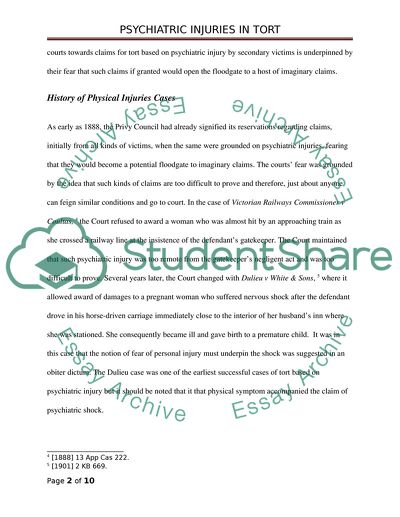Cite this document
(The UK Courts Attitude towards Relational Loss Claims Case Study, n.d.)
The UK Courts Attitude towards Relational Loss Claims Case Study. Retrieved from https://studentshare.org/law/1747463-the-case-of-relational-loss-secondary-victims-appears-to-provoke-a-defensive-stance-by-the-judiciary-and-the-primarysecondary-divide-with-the-more-favourable-rules-for-primary-victims-illustrates-this-discuss-in-the-light-of-claims-for-psychiatri
The UK Courts Attitude towards Relational Loss Claims Case Study. Retrieved from https://studentshare.org/law/1747463-the-case-of-relational-loss-secondary-victims-appears-to-provoke-a-defensive-stance-by-the-judiciary-and-the-primarysecondary-divide-with-the-more-favourable-rules-for-primary-victims-illustrates-this-discuss-in-the-light-of-claims-for-psychiatri
(The UK Courts Attitude towards Relational Loss Claims Case Study)
The UK Courts Attitude towards Relational Loss Claims Case Study. https://studentshare.org/law/1747463-the-case-of-relational-loss-secondary-victims-appears-to-provoke-a-defensive-stance-by-the-judiciary-and-the-primarysecondary-divide-with-the-more-favourable-rules-for-primary-victims-illustrates-this-discuss-in-the-light-of-claims-for-psychiatri.
The UK Courts Attitude towards Relational Loss Claims Case Study. https://studentshare.org/law/1747463-the-case-of-relational-loss-secondary-victims-appears-to-provoke-a-defensive-stance-by-the-judiciary-and-the-primarysecondary-divide-with-the-more-favourable-rules-for-primary-victims-illustrates-this-discuss-in-the-light-of-claims-for-psychiatri.
“The UK Courts Attitude towards Relational Loss Claims Case Study”, n.d. https://studentshare.org/law/1747463-the-case-of-relational-loss-secondary-victims-appears-to-provoke-a-defensive-stance-by-the-judiciary-and-the-primarysecondary-divide-with-the-more-favourable-rules-for-primary-victims-illustrates-this-discuss-in-the-light-of-claims-for-psychiatri.


